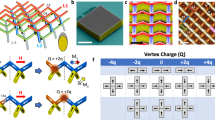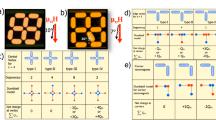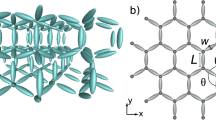Abstract
Free monopoles have fascinated and eluded researchers since their prediction by Dirac1 in 1931. In spin ice, the bulk frustrated magnet, local ordering principles known as ice rules—two-in/two-out for four spins arranged in a tetrahedron—minimize magnetic charge. Remarkably, recent work2,3,4,5 shows that mobile excitations, termed ‘monopole defects’, emerge when the ice rules break down2. Using a cobalt honeycomb nanostructure we study the two-dimensional planar analogue called kagome or artificial spin ice. Here we show direct images of kagome monopole defects and the flow of magnetic charge using magnetic force microscopy. We find the local magnetic charge distribution at each vertex of the honeycomb pins the magnetic charge carriers, and opposite charges hop in opposite directions in an applied field. The parameters that enter the problem of creating and imaging monopole defects can be mapped onto a simple model that requires only the ice-rule violation energy and distribution of switching fields of the individual bars of a cobalt honeycomb lattice. As we demonstrate, it is the exquisite interplay between these energy scales in the cobalt nanostructure that leads to our experimental observations.
This is a preview of subscription content, access via your institution
Access options
Subscribe to this journal
Receive 12 print issues and online access
$259.00 per year
only $21.58 per issue
Buy this article
- Purchase on SpringerLink
- Instant access to full article PDF
Prices may be subject to local taxes which are calculated during checkout





Similar content being viewed by others
References
Dirac, P. A. M. Quantised singularities in the electromagnetic field. Proc. R. Soc. A 133, 60–72 (1931).
Castelnovo, C., Moessner, R. & Sondhi, S. L. Magnetic monopoles in spin ice. Nature 451, 42–45 (2008).
Fennell, T. et al. Magnetic coulomb phase in the spin ice Ho2Ti2O7 . Science 326, 415–417 (2009).
Bramwell, S. T. et al. Measurement of the charge and current of magnetic monopoles in spin ice. Nature 461, 956–959 (2009).
Morris, D. J. P. et al. Dirac strings and magnetic monopoles in the spin ice Dy2Ti2O7 . Science 326, 411–414 (2009).
Pauling, L. The structure and entropy of ice and of other crystals with some randomness of atomic arrangement. J. Am. Chem. Soc. 57, 2680–2684 (1935).
Bramwell, S. T. & Gingras, M. J. P. Spin ice state in frustrated magnetic pyrochlore materials. Science 294, 1495–1501 (2001).
Ramirez, A. P., Hayashi, A., Cava, R. J., Siddharthan, R. & Shastry, B. S. Zero-point entropy in ‘spin ice’. Nature 399, 333–335 (1999).
Sherrington, D. & Kirkpatrick, S. Solvable model of a spin-glass. Phys. Rev. Lett. 35, 1792–1796 (1975).
Jaubert, L. D. C. & Holdsworth, P. C. W. Signature of magnetic monopole and Dirac string dynamics in spin ice. Nature Phys. 5, 258–261 (2009).
Wills, A. S., Ballou, R. & Lacroix, C. Model of localized highly frustrated ferromagnetism: The kagome spin ice. Phys. Rev. B 66, 144407 (2002).
Chern, G-W., Mellado, P. & Tchernyshyov, O. Two-stage ordering of spins in dipolar spin ice on kagome. Preprint at http://arxiv.org/abs/0906.4781 (2009).
Moller, G. & Moessner, R. Magnetic multipole analysis of kagome and artificial spin-ice dipolar arrays. Phys. Rev. B 80, 140409 (2009).
Moessner, R. & Schiffer, P. Monopoles on the move. Nature Phys. 5, 250–251 (2009).
Wang, R. F. et al. Artificial ‘spin ice’ in a geometrically frustrated lattice of nanoscale ferromagnetic islands. Nature 439, 303–306 (2006).
Tanaka, M., Saitoh, E., Miyajima, H., Yamaoka, T. & Iye, Y. Magnetic interactions in a ferromagnetic honeycomb nanoscale network. Phys. Rev. B 73, 052411 (2006).
Qi, Y., Brintlinger, T. & Cumings, J. Direct observation of the ice rule in an artificial kagome spin ice. Phys. Rev. B 77, 094418 (2008).
Wang, R. F. et al. Demagnetization protocols for frustrated interacting nanomagnet arrays. J. Appl. Phys. 101, 09J104 (2007).
Mengotti, E. et al. Building blocks of an artificial kagome spin ice: Photoemission electron microscopy of arrays of ferromagnetic islands. Phys. Rev. B 78, 144402 (2008).
Klaui, M. et al. Head-to-head domain-wall phase diagram in mesoscopic ring magnets. Appl. Phys. Lett. 85, 5637–5639 (2004).
O’Brien, L. et al. Near-field interaction between domain walls in adjacent permalloy nanowires. Phys. Rev. Lett. 103, 077206 (2009).
Petit, D. et al. Mechanism for domain wall pinning and potential landscape modification by artificially patterned traps in ferromagnetic nanowires. Phys. Rev. B 79, 214405 (2009).
Acknowledgements
This work was financially supported under grants from the EPSRC (EP/G004765/1) (W.R.B.) and the Leverhulme Trust (F/07058/AW) (L.F.C.).
Author information
Authors and Affiliations
Contributions
W.R.B. and L.F.C. are jointly responsible for all aspects of the work. S.L. carried out the MFM imaging and analysis and contributed to the preparation of the manuscript. D.E.R grew and processed the films and contributed to discussions. G.K.P. carried out the simulations.
Corresponding author
Ethics declarations
Competing interests
The authors declare no competing financial interests.
Supplementary information
Supplementary Information
Supplementary Information (PDF 9612 kb)
Rights and permissions
About this article
Cite this article
Ladak, S., Read, D., Perkins, G. et al. Direct observation of magnetic monopole defects in an artificial spin-ice system. Nature Phys 6, 359–363 (2010). https://doi.org/10.1038/nphys1628
Received:
Accepted:
Published:
Issue date:
DOI: https://doi.org/10.1038/nphys1628
This article is cited by
-
Clocked dynamics in artificial spin ice
Nature Communications (2024)
-
Electrically programmable magnetic coupling in an Ising network exploiting solid-state ionic gating
Nature Communications (2023)
-
Persistent dynamic magnetic state in artificial honeycomb spin ice
Nature Communications (2023)
-
Distinguishing artificial spin ice states using magnetoresistance effect for neuromorphic computing
Nature Communications (2023)
-
Combining two-photon lithography with laser ablation of sacrificial layers: A route to isolated 3D magnetic nanostructures
Nano Research (2023)



